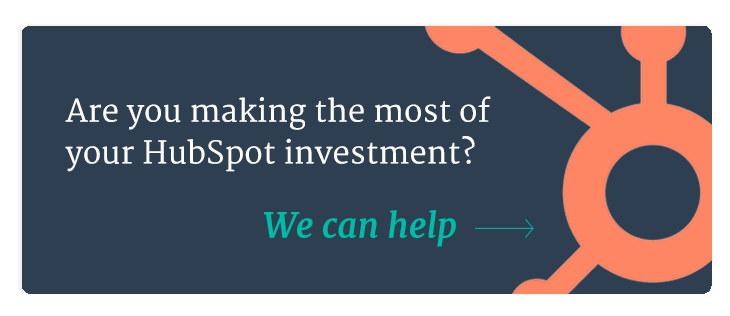
Lay the Foundation with a Successful HubSpot Onboarding

More than half of all B2B companies plan to adopt marketing automation software this year. Their No.1 criterion when choosing from over 100 different marketing automation platforms? Ease of implementation. This makes perfect sense, considering a return on such a lofty investment depends on multiple people understanding how to maximize automated technology. A lot can go wrong.
Indisputably, HubSpot rules the marketing automation category. Their automated software hits the trifecta: powerful capabilities, simple interface, exceptional customer support. However, expecting HubSpot to deliver results by merely having it is like expecting to reach your weight loss goal just because you bought a treadmill. If you want to get the most out of your investment, you need to take it out of the box, set it up correctly and make a plan. This is why a HubSpot onboarding strategy is so important. The framework for a successful implementation process involves three key phases.
3 Phases To Successfully Complete Your HubSpot Onboarding
Phase 1: Technical Setup
Pro Tip: Technical setup is easily the most important step in your onboarding process. However, because configurations must align with how you intend to use the software, this phase must be performed in tandem with Phase 2—strategic planning.
With marketing and sales strategies expanding to accommodate a growing number of touchpoints across the buyer’s journey, technical configurations are becoming a complicated patchwork of functions. Miss a stitch (or two), and campaigns may not perform as intended or worse, you could launch erroneous campaigns that damage valuable consumer relationships. When executed properly, your software will make marketing and sales data and activities highly accessible, manageable and measurable all in one place. Equally important, your software solution will automate workflows seamlessly.
Basic Checklist:
- Add users and assign access levels
- Install JavaScript tracking code
- Connect website domain
- Set up lead tracking
- Integrate your CRM
- Import contacts
- Set up blog
- Connect all social media accounts
- Integrate necessary external software (e.g., Salesforce or Google Ads)
Phase 2: Strategic Planning
Pro Tip: Marketing automation goes far beyond email. If you do not have a working knowledge of inbound marketing best practices, educate yourself before proceeding, or risk unraveling every other phase.
Begin strategic planning by prioritizing the results you wish to achieve using automation. The goals you set will inform decisions about what campaigns to run and how to measure performance.
[Download an Essential Content Marketing KPI Checklist for inspiration and guidance.]
Next, design workflows, set criteria to trigger workflows, and customize reporting features. As you tighten the bolts on your strategy, how you segment contact lists will play a significant role in how well your campaigns perform. For example, you can segment contacts by topic of offers downloaded, lifecycle stage, page views or lead source, and more.
Basic Checklist:
- Build personas and targeted lists
- Understand the buyer’s journey
- Set specific, measurable, achievable, relevant, time-bound (SMART) goals
- Define Key Performance Indicators (KPIs)
- Establish workflows and workflow criteria
- Develop email templates
- Customize report dashboards and analytics
Phase 3: Training
Pro Tip: Time is a universal pain point for marketing and sales professionals. To avoid unnecessary training: 1) Determine your team’s level of experience (beginner, intermediate, advanced) with automated software and inbound marketing best practices. And 2) Survey each professional to find out where they want and need the most support.
Begin by identifying each member of your core team structure — for example, the project manager, decision-maker, content creator, and implementer. After establishing the team’s level of experience and areas of interest, develop an onboarding timeline and build out the lesson plan. Use HubSpot Academy (a free online training program for inbound marketing, sales, and customer service professionals) to supplement in-house training. Additionally, plan to incorporate projects that provide experiential learning opportunities for employees. Lastly, don't forget to provide ongoing education for employees. One of HubSpot's many qualities is its dedication to ongoing improvement. As marketing technology evolves, your staff will need the skills to leverage exciting and powerful new software capabilities and features.
Basic Checklist:
- Establish core team members
- Determine the education level of the team
- Develop an onboarding timeline
- Incorporate educational resources like HubSpot Academy
- Create experiential learning opportunities.
You can go the DIY route and piece together advice from online forums and customer support. However, if you do not have the time, knowledge and skills to roll out a comprehensive HubSpot onboarding and training process, don’t wing it.
Your other option is to seek a HubSpot onboarding service provider like Kuno Creative. From technical setup to training, your company will have a dedicated team of HubSpot experts handling all the legwork. We ensure that every phase of implementation is customized, completed correctly, and optimized to deliver all of the benefits of automated technology without all of the headaches.






